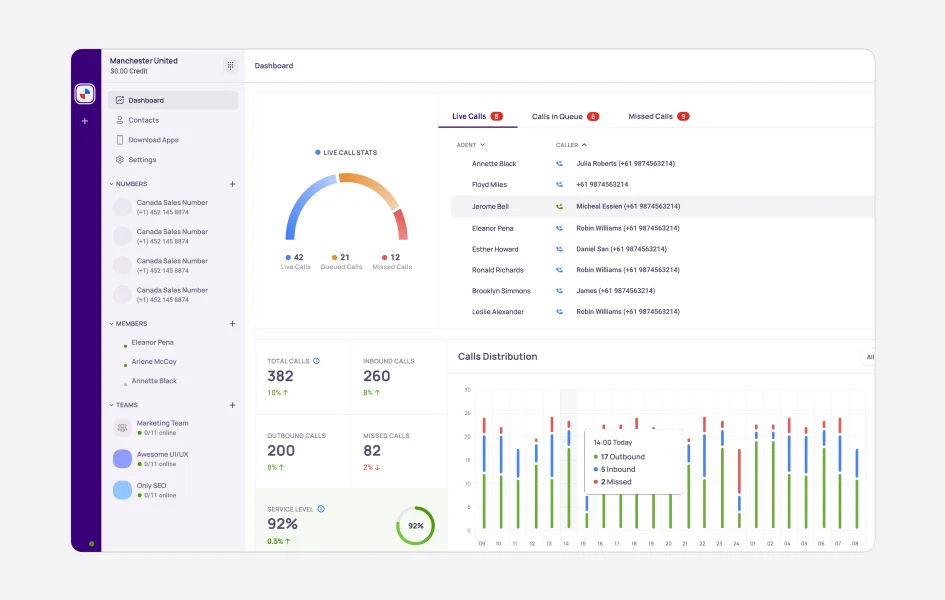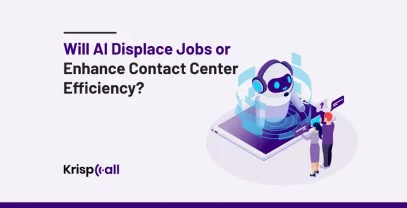The disconnect between customer needs and service delivery creates long wait times, frustrated callers, and overworked agents. The good news?
Contact center automation trends are emerging as a game-changer. By leveraging cutting-edge technologies, businesses can transform their contact centers into dynamic hubs that deliver exceptional customer experiences.
Let’s dive into the hottest trends in contact center automation and explore how they are revolutionizing the way businesses connect with their customers.
🚀 Key Highlights
- Contact center automation uses tools like artificial intelligence (AI), robotic process automation (RPA), and natural language processing (NLP) to automate tasks and enhance communication efficiency.
- The contact center automation trends benefit businesses by improving efficiency, enhancing agent productivity, 24/7 availability, data-driven insights, and Scalability.
- The major emerging Contact Center Automation Trends are AI-powered virtual assistant, Omnichannel Communication, Customized Customer Interactions, Remote Work and Virtual Agents, Real-Time Analytics and Reporting, Voice Biometrics, Self-Service Tools with Automation, Continuous Learning and Improvement, Augmented Reality (AR) and Virtual Reality (VR), Emotional Intelligence AI.
- The types of businesses & industries that benefit from contact center automation are high-call volume industries, industries with repetitive inquiries, and businesses seeking improved customer experience.
- KrispCall is one of the next-generation cloud-based contact center software with a user-friendly interface and automation capabilities, that empower you to handle customer interactions and increase your agent’s productivity.
What is contact center automation?
Contact center automation simply means the use of technology to improve and streamline customer interactions within a call center environment, employing tools such as artificial intelligence (AI), robotic process automation (RPA), and natural language processing (NLP) to automate tasks and enhance communication efficiency.

Automation offers businesses a considerable opportunity to enhance their contact center efficiency. By efficiently handling repetitive tasks, the software allows agents to address more intricate issues. Self-service alternatives such as chatbots empower customers to resolve problems independently, leading to shorter wait times and reduced agent workload.
Moreover, automation improves the routing of communications and furnishes agents with real-time data. This leads to heightened efficiency, improved customer service, decreased costs, and valuable insights for enhancing service delivery.
What are the Benefits of Contact center automation?
- Improved Efficiency: Contact center automation simplifies repetitive tasks like data entry, call routing, and scheduling calls automatically without manual input helping reduce wait times. While also helps to analyze data which helps to predict call volume and allocate resources effectively.
- Enhanced Agent Productivity: Automation eliminates mundane tasks, which allows agents to save time and use it to focus on bringing quality results at work. Agents can provide more personalized and efficient customer service.
- 24/7 Availability: Contact center automation makes sure to be available for its customers even outside of regular business hours, which enhances customer satisfaction. Whereas basic inquiries and support are fulfilled through chatbots and self-service options.
- Data-Driven Insights: Automated insights on customer interactions and overall data allow businesses to understand their customers. It also allows identification patterns of customers in the market to attract more customers and identify areas for improvement.
- Scalability: The contact center can adapt according to changes within the business. It doesn’t need to make any significant change in infrastructure or additional, it’s more of an upgrade in the system, automation itself is scalability.
10 Emerging Contact Center Automation Trends in 2024
In every sector globally the trends keep on changing, and the same concept is applied to the contact center industry as well.
Emerging automation trends in contact centers have affected how an organization communicates to its customers. Some of the trends that are on the rise and will impact the future of contact center business are:
1. AI-Powered Virtual Assistant
Within contact center automation, an AI-powered virtual assistant is an advanced software tool crafted to imitate human dialogue and deliver automated assistance to customers. As we look into 2024, the primary objective of AI virtual assistants is to enhance customer service by providing immediate aid.

AI-powered virtual assistants can be operational 24/7, ensuring customers receive assistance irrespective of the time.
67% of customers prefer self-service options for simple inquiries. Furthermore, the AIVA can deflect up to 30% of customer inquiries, leading to significant cost savings for contact centers.
Zendesk
The global virtual assistant market is expected to reach $29.2 billion by 2026. It is also beneficial for agent’s productivity as PWC reports that agents can save 30% of their time through AI automation
Grand View Research
Some examples of AI-powered virtual assistants are chatbots and virtual assistants that handle routine inquiries, provide basic troubleshooting steps, and qualify leads. Due to advancement, it can also involve sentiment analysis & Predictive analytics to suggest solutions for customer queries, reducing resolution times.
2. Omnichannel Communication
Combining different communication channels will facilitate smooth exchanges across platforms, enabling customers to transition between channels without losing context, while also offering agents a holistic perspective of customer interactions in omnichannel communication.
An Accenture study highlights that Omnichannel routing helps direct inquiries to the most appropriate agent based on skillset and channel preference which improves agent efficiency by 20%.
Omnichannel history enables agents to see past interactions across all channels for a complete customer view. Automated ticket routing directs inquiries to the right department or agent based on keywords or urgency.
This approach facilitates customers interacting with a contact center across various channels with ease, seamlessly moving between them without disruption. For instance, a customer might initiate contact via email and smoothly transition to a chat session without the need to repeat information.
3. Customized Customer Interactions
Personalization is key to improving customer satisfaction. Automation can help by:
- Dynamic self-service options: Recommending relevant knowledge base articles or FAQs based on the customer’s specific needs.
- Context-aware chatbots: Using customer data and past interactions to provide personalized greetings and solutions.
- Targeted agent recommendations: Suggest the most suitable agent based on the customer’s issue and past interactions.
4. Remote Work and Virtual Agents
Due to advancements in communication technology and the global effects of the COVID-19 pandemic, the trend of remote work and remote teams has experienced significant growth.
According to findings from Global Workplace Analytics, remote work has increased by 173% since 2005, notably spiking between 2019 and 2021.
The user bases of platforms like Upwork and Freelancer have shown growth, hinting at a trend towards gig-centric Virtual agents. This practice has resulted in agent benefits such as increased agent satisfaction, decreased overhead costs associated with contact center facilities, and the ability to attract talent from worldwide channels.
The remote work and virtual agents depend highly on Cloud-based contact centers which allow automated scheduling and performance management and explore the use of Virtual collaboration tools.
5. Real-Time Analytics and Reporting
Real-time contact center analytics and reporting are integral to contact center automation, involving the ongoing examination of data from customer interactions to deliver instant insights and feedback.
By utilizing call analytics tools, contact center supervisors can promptly pinpoint emerging trends, obstacles, or issues within the contact center environment, enabling them to take informed actions and implement necessary adjustments to enhance operations, customer service, and overall efficiency.
Real-time dashboards help in overall call monitoring key metrics like call volume, agent performance, and customer satisfaction in real-time. Automated reporting Generate reports on key performance indicators (KPIs) to identify trends and areas for improvement. Predictive insights use historical data to predict peak call times and resource allocation needs.
6. Voice Biometrics
In contact centers, voice biometrics is another automation trend used to distinguish vocal traits and patterns to authenticate callers’ identities. Contact centers are leveraging voice biometrics to verify users in real-time as a strategic approach for secure interaction and reduce fraud activity, especially seen during the pandemic.

Voice biometrics you can easily analyze elements like pitch, tone, rhythm, and pronunciation of humans, this technology constructs a digital representation of a person’s voice.
The market for voice biometrics will expand from $1.3 billion in 2021 to $4.8 billion by 2028, with a compound annual growth rate of 20.6%.
According to Insight Partners analysis
Instead of depending on traditional methods such as PINs or passwords, with voice biometrics, you can get a more secure and convenient way to confirm the identity of callers. Once a customer’s voiceprint is enrolled in the system, it can be automatically recognized during future interactions without requiring additional verification procedures.
7. Self-Service Tools with Automation
Empowering customers to find solutions independently can improve satisfaction and reduce call volume. Automation can enhance self-service by:
- Interactive voice response (IVR) systems: Utilizing AI and natural language processing for more intuitive self-service experiences.
- Automated knowledge base updates: Ensuring current and relevant knowledge base articles based on customer inquiries.
- Smart chatbots: Providing step-by-step guidance and troubleshooting assistance within self-service interfaces.
8. Continuous Learning and Improvement
Continuous Learning and Improvement within Contact Center Automation signifies a persistent effort to polish and elevate automated systems employed in contact centers to handle customer interactions.
This continual process depends on the examination of data and feedback obtained from different channels, such as customers, agent performance metrics, and system analytics.
Through the implementation of Continuous Learning and Improvement, contact centers gain the capacity to enhance daily operation, customer satisfaction, and increase business growth by effectively automating routine tasks and processes.
9. Augmented Reality (AR) and Virtual Reality (VR)
Augmented Reality (AR) and Virtual Reality (VR) are advancing as cutting-edge tools for enriching customer support encounters. With AR, digital elements blend seamlessly into the physical world, enabling contact center agents to provide remote, real-time guidance or instructions to customers.

For instance, agents can use AR to visually guide customers through troubleshooting steps or demonstrate product features. Virtual Reality, on the other hand, immerses users in a completely virtual environment.
Both AR and VR hold the potential to revolutionize customer support by providing more interactive and engaging experiences, leading to increased customer satisfaction and more effective agent training.
10. Emotional Intelligence AI
In the landscape of Contact Center Automation Trends, Emotional Intelligence AI refers to artificial intelligence systems equipped with the ability to perceive, understand, and respond to human emotions effectively.
By leveraging advanced algorithms and natural language processing capabilities, Emotional Intelligence AI can identify customer sentiments, whether they’re frustrated, satisfied, or confused, and tailor responses accordingly.
Additionally, Emotional Intelligence AI can assist agents by providing real-time emotional insights during interactions, helping them navigate challenging situations with greater empathy and effectiveness.
What types of businesses or industries benefit from contact center automation?
Contact center automation is implemented in almost every modern business that needs to deal with a large number of clients, customers, businesses, or even its employees. To make it more clear here are some of the industries and businesses that benefit from contact center automation:
1. High Call Volume Industries
Contact Center Automation is highly used for high-call industries, where the flow of customers is more continuous. Some of the examples are:
- Travel and Hospitality: Airlines, hotels, and travel booking agencies must connect with their customers daily for flight confirmations, reservation changes, and basic itinerary inquiries. By automating such tasks a huge amount of time can be saved.
- Customer Service: Companies dealing with frequent customer queries, such as banks, telecom firms, and utility providers, can utilize automation to enhance operational efficiency and significantly cut down on customer wait times.
2. Industries with Repetitive Inquiries
If your businesses receive a lot of similar inquiries from customers then you could improve the process by using automated systems in their contact centers. These systems make interactions smoother and help them work better.
- Healthcare: Hospitals and medical facilities commonly receive repetitive phone calls for activities such as scheduling appointments, renewing prescriptions, inquiring about billing, and obtaining general health-related details such as operating hours and accepted insurance plans.
- Technical Support: When it comes to tech support you need to communicate with clients who have specific issues related to tech such as software installation, troubleshooting tech bugs, hardware malfunctions, internet connectivity issues, modern configurations, and more.
3. Businesses Seeking Improved Customer Experience
Businesses such as e-commerce, retail, and so on that focus on dealing with customers regularly to enhance customer experience can employ contact center automation in multiple ways. Thus it allows your business to improve interactions with customers and increase overall satisfaction.
- E-commerce: Using cutting-edge technology like artificial intelligence (AI), online stores can automate tasks to create a smooth and personalized shopping experience for each customer. This not only makes shopping easier but also leads to happier and more loyal customers.
- Field Service Companies: For field service companies, juggling customer inquiries, scheduling appointments, and ensuring smooth technician workflows can be a complex task. Traditional contact centers, often reliant on manual processes, can struggle to meet the dynamic needs of this industry.
Upgrade to Next-Gen Cloud-Based Contact Center Software – KrispCall
In today’s competitive business landscape, customer experience is a key indicator. Around 73% of customers agree that valuing their time and providing effortless experiences is critical to building loyalty. Traditional contact centers often face limitations due to their reliance on on-premises infrastructure and constrained capabilities, making it difficult to meet the growing expectations.

KrispCall’s latest cloud contact center software boasts a user-friendly design and automated features, empowering you to efficiently handle customer interactions. Which results in notable enhancements to your agents’ productivity, typically between 15% and 30%.
KrispCall empowers businesses with effective and efficient solutions, eliminating the necessity for costly setups and complicated maintenance. According to Gartner’s projections, by 2025, the majority of 85% of contact centers will operate on cloud-based platforms, illustrating the industry’s movement towards this cost-efficient and adaptable approach.
Want to boost efficiency & reduce costs for your business at the same time? Why not get a free Contact Center Software demo today with KrispCall?
How to Set Up Contact Center Software?
KrispCall lets you configure your cloud-based contact center software, in just a few minutes. Here’s how to begin your contact center:
- Create a KrispCall Account and access the dashboard.
- Procure virtual numbers from your chosen country.
- Invite agents, allocate numbers, and integrate with CRMs.
- Start making and receiving calls promptly.
Future of Contact Center Automation
The trend of Contact Center Automation signifies a significant change in how businesses handle customer interactions, utilizing technology to boost effectiveness, enrich customer experiences, and foster expansion. With a growing acknowledgment among companies of automation’s vital role in simplifying processes and maintaining competitiveness, solutions such as KrispCall become essential assets in adapting to this evolving environment.
Essentially, KrispCall goes beyond being a mere solution; it serves as a valuable strategic partner for businesses aiming to excel in the Contact Center Automation trend. Be a smart contact center business owner by utilizing emerging trends in your organization to achieve heightened efficiency, productivity, and customer satisfaction, positioning yourself for success in the digital era with KrispCall.





